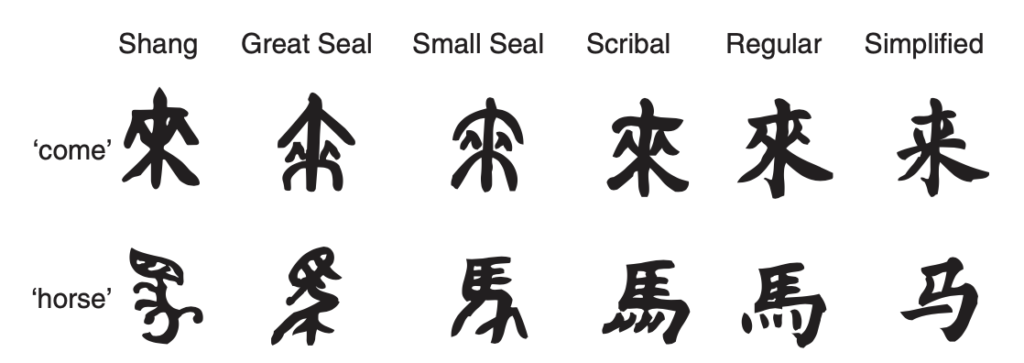Cuneiform
Evolves from pictograms to wedge-shaped cuneiform signs in Sumer around 2500 BC. Evolved into Babylonian, Assyrian, Hitite. Used by the Akkadian and Elamites also. It evolved over the centuries, especially in orientation and abstraction. And eventually into an alphabetic Persian (~500 BC). Used until 75 AD.
Egyptian Hieroglyphs and Scripts
Pictographic scripts remained almost the same from its inception and throughout its 3000 year history. Around 2700 BC, a cursive form of hieratic script was developed from the hieroglyphs, for more administrative and business purposes mainly on papyri. And eventually, while hieratic became an almost exclusive religious script, a new demotic script form was developed to keep the administration, commerce and some inscriptions
Linear A and B “Minoan” scripts
Although some hieroglyphic seals were discovered and dated from around 2100 BC in Crete, it was the scripts found in the Minoan palace that are dubbed the first European scripts. Ranging from Crete to Anatolia, these were probably records of coexisting scripts that (in the case of Linear B) were used to record archaic Greek and ceased to exist around 1200 BC.
Chinese scripts
Chinese belongs to the Sino-Tibetan family of languages, which may be loosely compared to the Indo-European family.
Robinson, 2009, p. 110
Signs recorded in “dragon bones” date from about 1400–1200 BC, during the Shang Dynasty. They show a rudimentary resemblance to present-day symbols and only ~1/4 have been deciphered. And, as today, this early script shows that even though it may have had a pictographic origin, its iconic representation has evolved and it wasn’t the main nor the only design principle. Like all the writing systems that have existed, it also combines some sort of symbolic and phonetic aproach.
Chinese script is the longest surviving script in use. It was shaped and evolved through different social and cultural iterations, as well as political reforms throughout history. It features almost 50 000 different symbols Although only a fraction is needed for everyday writing.

Today, the simplified script is in use in mainland China. But due to the need of digitization and internationalization they also use a romanized phonetic version called Pin Yin that dates from 1958.
Chinese scripts were disseminated throughout the nearby nations. Nevertheless, dialects and culture made them all different.
In Korea, Chinese was substituted by Hangul in 1440, an alphabet system invented by King Sejong, as the official script. But both still coexist.
Meso-American scripts
(In progress…)
Olmec & Zapotec (and Mayan?) and Isthmian

Cherokee
[The Cherokee] ‘alphabet’, [was] invented in the United States in 1821 by the Cherokee warrior Sequoyah. This remarkable system, with 86 signs, is really a syllabary, not an alphabet, based largely on assigning syllabic values to the individual letters of the Roman alphabet.Robinson, 2009, p. 101
Rongorongo
The Polynesian language script from Easter Island. Not much is known about this mysterious script. It may have been invented in the 18th century, after the influence of Europeans.
Indus script(s)
(In progress…)
Missing in this picture is the Slavic scripts. An adaptation of the Latin and the glagolithic in the 9th century and later influenced set into the common Cyrillic we know today in the 12th century.
Runes and northern European Scripts
Although not entirely understood, this symbol language was in use by the northern English, Germanic, Goths, Danish and other tribes that even reach Russia since 2nd century AD.